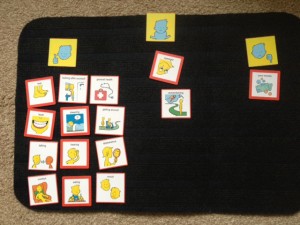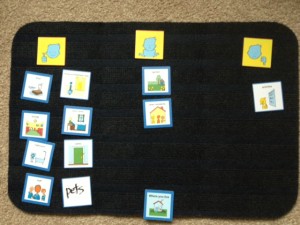I undertook the ‘Talking Mats’ on-line course to acquire a new skill and a way to enhance my communication with people with dementia in practice. I have found the learning strategies used are varied and interactive – so there is not a sense of sameness, even though visually there is a consistent layout to the presentation of each module (this expedites navigation). This enhances engagement and my interest so that I am never reticent in logging on to complete the next module! In the beginning, I felt that I could move a lot quicker through the course if the modules were available once each part was completed, instead of having to wait for feedback on each assignment. However, nearing the end of the training course, the benefits of this approach are now clearer. Spaced learning and spaced practice allows for thinking time and internalisation of the module components. In this way, I have come to appreciate the part skills involved in the overall process and how they come together. I now find myself observing the skills involved and the reactions of all communicating as well as the surrounding environment, body language etc. I have also found myself looking back over the past module materials to ensure I am integrating as I go and to remind myself of the rationales for the actions that need to be taken, as well as ensuring that I am more and more familiar with the new terminology that I have been exposed too.
Little did I know when I signed up that the benefits of learning about and how to use ‘Talking Mats’ would stretch wider than what I initially anticipated or wanted! In completing the course, I am now much more aware of my communication practice in general, and the part-skills involved. I can also now see the wide applicability of ‘Talking Mats’ to different populations, age groups and conditions. Communication is everywhere but it needs to be efficient and effective – I am now more confident that my communication practice will improve as a result of this course. For me this is the best outcome possible.
Please click here to find out how to book on the next course
Guest Blog by Ruth Cape
Ruth is Lois Cameron’s daughter and she has contributed the following guest blog about her recent experience of taking and passing her driving test and how using a Talking Mat the night before her test developed a nerve controlling action plan!
My Driving test -a nerve wracking prospect
Even the simplest of actions within the context of a nerve-wracking event can be magnified to stomach churning proportions. The thought of opening a car door and putting on a seatbelt has never before given me much trouble. Now suddenly I’m imagining fumbling with the handle, not finding the seatbelt lock – or worse, forgetting the thing altogether; while trying to look cool and collected in front of a reportedly ‘no-benefit-of-the-doubt’ driving test examiner. It was the night before my practical driving test. I had recently failed on a nerves-getting-the-better-of-me manoeuvre and knew I’d be unlikely to get another test for 3 months if this one didn’t work out. I live on the Isle of Harris. Winter gales make cycling difficult, if not often impossible. Winter busses are sporadic. My housemate-cum-chauffeur-cum-co-driver had just left the island. My driving lessons in Stornoway required a four hour round trip. To put it lightly, I was pretty keen to pass. If I’m honest, even if I knew I could get another test the next week and if my day to day life wouldn’t be much effected by the use of a car, simply the thought of 40 minutes in that vehicle-turned-pressure-cooker, every move scrutinised by a stranger in a high-vis would have given me the tangled stomach I suffered from that test eve.
Talking Mat trialled as a pre-driving test nerve-gatherer
Timing was on my side this time round; my mum – Lois – and her colleague – Sally – happened to be on a Talking Mats training visit to Stornoway that pre-test day. Finished with a day of training, we met for dinner and, as plates were cleared away and calming herbal tea was ordered, out came the pen, paper and post-it notes. This – I gather – was the first Talking Mat trialled as a pre-driving test nerve-gatherer; proving just how versatile a tool it is. With a top-scale to gauge my confidence levels, different aspects of the test were handed to me and ended up in a cluster around the lower two steps of the scale; opening the door and putting on my seatbelt sat just a little above parallel parks and three point turns. While this mostly went to show that it was the whole experience that was knotting my insides, it allowed a valuable opening for discussion on how to go about unknotting, or at least concealing the knots.
Reframing thoughts and strategies for success
Re-framing the nerves to focused adrenalin, positive mantra, power posing and deep breaths – the mediation of the Mat provided the opportunity to work through strategies for success. I went to bed, glad – at least – to have had something to do to that evening to channel the nervous energy. The following morning I opened that car door, put on my seatbelt and proceeded to pass with one minor. Now, I can’t allow Talking Mats to take all the credit for this turn of events, but I can definitely praise the tool and thank my two informal practitioners for keeping me focused. From this experience, I’m sure there is potential for a wider Talking Mats scope for tackling anxiety and for use in relation to stressful situations.
Now Harris has opened up, and I’m off to explore…
When I went back to the Care Home where I was piloting our new Social Care symbols the staff told me this story about Ann (see previous blog). Apparently she usually is very quiet and never joins in with activities or with other residents. However when we used Talking Mats with the Activitiies symbols, she told me that she really likes singing and had started singing to me. Later that day, one of the care staff had suggested that she sing again and Ann started a song with him. Gradually other residents joined in and they had a lovely sing-song with Ann leading it!
On another day I used the Social Care symbols with Dorothy who tends to go off track and repeat stories over and over. She was quite sure about what she liked and didn’t like about the Care Home and using Talking Mats was a gentle and easy way to bring her back on topic.
I recently used the ‘Talking Mats Social Care’ pack in a Care Home with 3 residents, Ann, Barbara and Colin, who all have dementia. Neither Ann nor Barbara were wearing their glasses but all three were able to see and recognise the symbols and use Talking Mats to express their views. All three conversations took place in the lounge where the TV was on, staff were moving around and and where other residents were chatting.
Ann, whose mat is at the top of this blog, used the ‘Activities’ set and very quickly understood what to do although at times she needed to be reminded what the top scale meant. She said she was a very happy person and didn’t think I would find anything that she didn’t like but as we went through the symbols she became more thoughtful and said that she did not like DIY, exercise or knitting and sewing. She used the mid-point to indicate the things she used to enjoy but does not do now. She was delighted when she saw how positive her overall mat was.
Barbara used the ‘You’ set to tell me how she felt about herself. Although she could have placed the symbols, she preferred to sit back, tell me what she thought and let me place them for her. She felt fairly positive about most things although she was aware that her eyesight and her memory were not as good as they used to be. She also joked that she never had enough money.
Colin has dementia and is also profoundly deaf. He has only recently moved into the care home so we used the ‘Where you live’ set of symbols. Colin said several times that he didn’t think there was any point in having a conversation as he can’t hear. However after writing down the reason for doing it, he gradually realised that he could use the symbols to understand what I was asking and then express himself. He said he was generally happy with the Care Home although he missed his garden and found it hard to make friends now as he cannot hear what the other residents are saying. He also felt there are not enough activities that he can take part in. He mentioned that he has a pet dog but doesn’t know what has happened to it since he moved. One of the staff said he would try to find out. He seemed satisfied with the final mat and staff felt it would be useful to use Talking Mats more with him to reduce his isolation.
 Online training login
Online training login 





